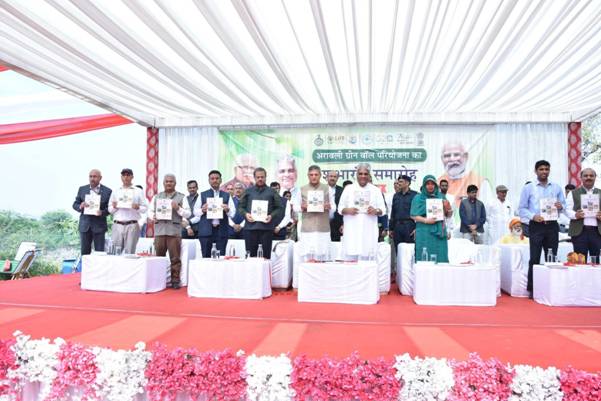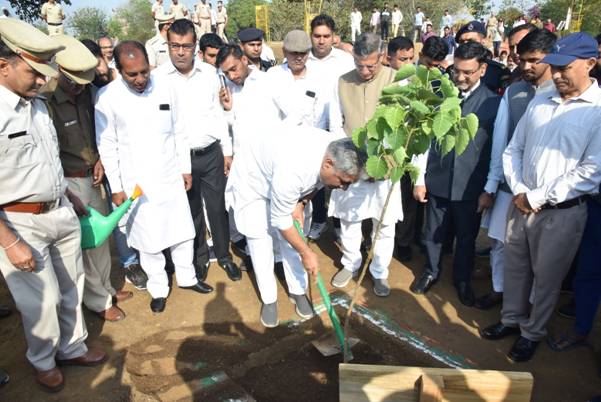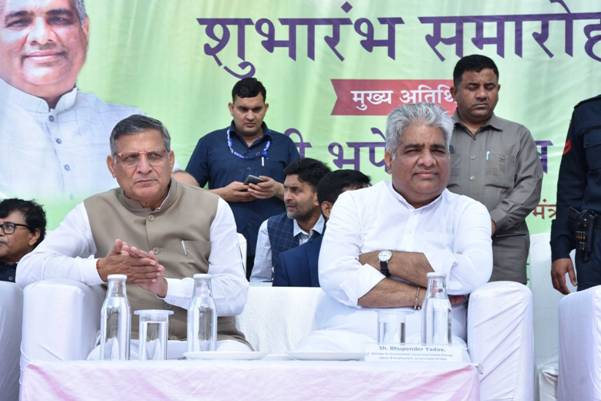
Union Minister for Environment, Forest and Climate Change, Shri Bhupender Yadav said that under Prime Minister Shri Narendra Modi India is moving to revive the Aravallis through various initiatives like single-use plastic ban, water conservation efforts and natural resources protection. Shri Yadav today launched the Aravalli Green Wall Project, a major initiative to green the 5 km buffer area around the Aravalli Hill Range in five states at a function organised to celebrate the International Day of Forests at Tikli Village in Haryana. At the event, Shri Yadav unveiled the National Action Plan to Combat Desertification and Land Degradation Through Forestry Interventions and a FAQ on Agro-forestry published by Indian Council of Forestry Research and Education. The Union Minister also participated in a plantation drive.
Addressed an event to inaugurate the Aravali Green Wall initiative in Tikli, Gurugram.
Under PM Shri @narendramodi ji, through various initiatives like single-use plastic ban, water conservation efforts and natural resources protection, India is moving to revive the Aravalis. pic.twitter.com/A3FkKr9cqd
— Bhupender Yadav (@byadavbjp) March 25, 2023
Speaking on this occasion, the Union Minister said that the Aravalli Green Wall Project will not only increase the green cover and biodiversity of the Aravalli through afforestation, reforestation and restoration of water bodies, but also improve the soil fertility, water availability and climate resilience of the region. He said that the project will benefit the local communities by providing them with employment opportunities, income generation and ecosystem services. He appreciated the efforts of the Haryana Forest Department and other stakeholders for their cooperation and support in implementing the project and reiterated the government’s commitment to achieve the national goal of creating an additional 2.5 billion tonnes of carbon sink by 2030.

The Union Minister said that rejuvenation of water bodies and catchment of the local streams will help in improving the overall soil moisture regime, productivity and drought resilience. He highlighted the importance of developing synergy between restoration, socio-economic factors and development activities to ensure that both conservation and development can be achieved.

Speaking at the event, the Haryana Minister of Forests & Wildlife, Shri Kanwar Pal Gurjar emphasized the importance of afforestation and restoration of degraded forests to mitigate the effects of climate change. He spoke about the Forest department’s ongoing efforts to increase the state’s green cover and protect its wildlife. He appreciated the efforts of Government of India for restoration of the Aravalli landscape particularly in context of Haryana. This event was attended by senior officials from Government of India and Government of Haryana.

Aravalli Green Wall Project in Haryana
In the initial phase, 75 water bodies will be rejuvenated under the project, starting with five waterbodies each in every district of Aravalli landscape on March 25th. The project will also include large-scale plantation drives and conservation of water resources in the Aravalli region. The project will cover degraded land in Gurgaon, Faridabad, Bhiwani, Mahendergarh and in Rewari districts of Haryana. Voluntary organization, Society for Geoinformatics and Sustainable Development and NGO, IMGurgaon are being engaged to mobilize people for Shramdaan for revival of water bodies at Bandhwadi and Ghata Bundh respectively.
About Aravalli Green Wall Project
The Aravalli Green Wall Project is part of the Union Environment Ministry’s vision to create green corridors across the country to combat land degradation and desertification. The project covers states of Haryana, Rajasthan, Gujarat and Delhi – where the Aravalli hills landscape span over 6 million hectares of land. The project will involve planting native species of trees and shrubs on scrubland, wasteland and degraded forest land, along with rejuvenating and restoring surface water bodies such as ponds, lakes and streams. The project will also focus on agroforestry and pasture development to enhance the livelihoods of local communities.
The Aravalli Green Wall Project has the following objectives:
- Improving the ecological health of the Aravalli range
- To prevent eastward expansion of Thar Desert and to reduce land degradation by creating green barriers that will prevent soil erosion, desertification and dust storms
- This green wall will help in carbon sequestration and mitigating climate change to enhance the biodiversity and ecosystem services of the Aravalli range by planting native tree species in the Aravalli region, providing habitat for wildlife, improving water quality and quantity.
- Promote sustainable development and livelihood opportunities by involving local communities in afforestation, agro-forestry and water conservation activities that will generate income, employment, food security and social benefits.
- The project will be executed by various stakeholders such as central and state governments, forest departments, research institutes, civil society organisations, private sector entities and local communities. Adequate funding, technical skills, policy coordination and public awareness will be called upon to ensure the success of the project.
- Contribute to India’s commitments under various international conventions such as UNCCD (United Nations Convention to Combat Desertification), CBD (Convention on Biological Diversity) and UNFCCC (United Nations Framework Convention on Climate Change).
- Enhancing India’s image as a global leader in environmental protection and green development.
***
MJPS/SSV


